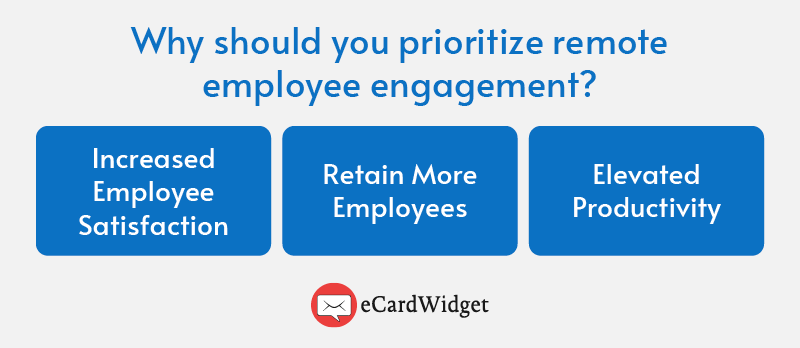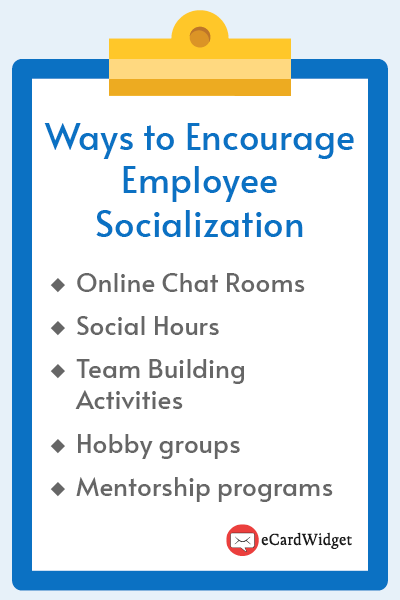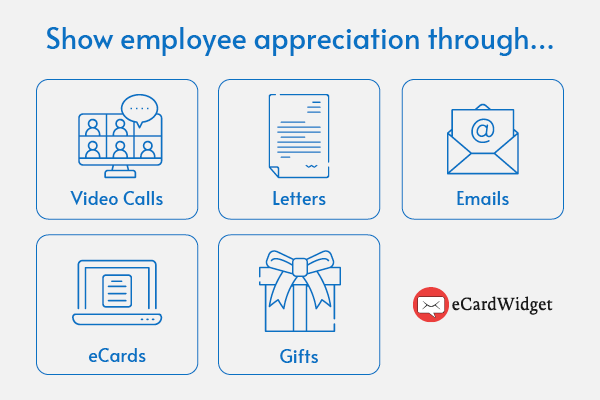Employee engagement is consistently at the forefront of employers’ minds, as they regularly search for ways to improve their employees’ experiences within the workplace. It’s easier to connect with in-person employees that you see every day. However, with the rise of remote job opportunities, it’s become increasingly important for companies to learn how to engage employees in the virtual space.
In this article, we’ll cover the following topics to help you engage with your remote employees:
- Why is remote employee engagement important?
- 3 tips for promoting an interconnected remote workplace
- How to engage remote employees: 7 strategies
Ultimately, the goal of employee engagement is to cultivate a positive work environment where employees find their jobs enjoyable and fulfilling and to foster a workplace culture in which employees support each other in meeting the company’s goals. This applies to all sorts of organizations, including businesses and nonprofits, that are dedicated to retaining their remote employees.
Before we dive into different strategies you can utilize for employee engagement, let’s begin by going over the specifics of why it’s important to build relationships with your employees.

Why is remote employee engagement important?

When you engage with your employees, they’re likely to feel more committed to your organization’s success. This results in the following benefits:
- Increased satisfaction. According to a study by Enboarder, employees who feel more connected with their coworkers are 96% more likely to be satisfied with their jobs. This means that engaging with employees regularly results in happier employees and a more positive work environment.
- Higher employee retention rate. Employees that are happier with their jobs and more committed to their employers are more likely to stay at their current workplace for longer.
- Elevated productivity. When you connect with your employees and create a positive work environment, they will feel more passionate about their work and will have increased productivity.
Adults spend the majority of their waking hours at work. For remote employees especially, who lack the same opportunities to build relationships with coworkers as in-person employees, staying motivated and engaged with their work can be difficult. Although some people thrive on a remote system without additional engagement, others need some form of interpersonal connection to flourish. Employers can support all of their employees, no matter their preferences, by offering team engagement opportunities.
3 tips for promoting an interconnected remote workplace
In this section, we’ll go over three overarching tips for creating a more connected and engaged remote workplace. Let’s dive in!
1. Communicate regularly.
Encourage your remote employees to regularly communicate with each other within their teams, through chat rooms, video calls, and email. Not only will this create stronger relationships between coworkers, but it will also improve your operations as your employees will feel more at ease reaching out to one another if any issues or concerns arise.
Additionally, you should make sure to be as transparent as possible with your employees. This is especially important for remote employees, who you do not see in the office every day and may not receive information as quickly as in-person employees. Your transparency and eagerness to communicate will show employees that you want them to be informed about what’s going on within your organization. In turn, that will make them feel more engaged.
2. Promote working together.
Remote work can be very isolating. This is especially true if an employee is in a role that isn’t customer-facing or can be performed alone, which can lead to them disengaging from their coworkers. To combat this and engage your remote employees, encourage them to work together when problems arise. Not only will this allow them to socialize, but it will help build teamwork skills.
3. Foster a culture of employee recognition.
To truly engage and recognize your employees, you must create a culture that centers employee recognition. You can do this in a couple of ways, including:
- Emphasizing peer-to-peer recognition. While it’s nice to hear your boss say that you’ve done a good job, it can be very impactful for employees to hear from coworkers that their work is appreciated. Encourage remote employees to call out their coworkers’ great work and to say thank you for the little things as well as the big.
- Employee of the Month program. You can establish a program dedicated to recognizing different employees each month. Aside from the recognition they receive, you can also provide them with a reward for a job well done.
- Celebrating Employee Appreciation Day. This special day occurs on the first Friday of March every year and provides the perfect opportunity to show gratitude for your hard-working team members. Try sending employee appreciation eCards, handing out thoughtful gifts, or catering lunch.
One of the reasons why people feel unsatisfied with their jobs is that they feel that the effort they make is not recognized by their coworkers or employer. By fostering a culture of employee recognition, all your employees will feel appreciated and will be more likely to remain at your organization.
How to engage remote employees: 7 strategies
Now that you know three tips for promoting a more interconnected remote workplace, let’s go over seven strategies for engaging remote employees.
1. Encourage employee socialization.

Remote work can be lonely without chances to socialize with peers. To combat the lonely feeling that can impact remote work, encourage your employees to socialize in the following ways:
- Set up online chat rooms. If you’re using a work platform such as Slack or GroupMe, create chat rooms for each of your teams. Encourage them to chat with one another during breaks throughout the day. This will help your employees form relationships with one another.
- Social hours. For some employees, sending chats isn’t enough of a connection. For those employees, host virtual socialization hours such as coffee chats or happy hours. You can encourage attendees to turn on their cameras and chat with one another to simulate socializing in person.
- Team building activities. Host a virtual team-building event outside of work hours such as a trivia night, game night, or a movie watch party.
- Hobby groups. Some employees will want to connect with others over shared hobbies. Groups like book clubs, photography groups, or arts and crafts circles will give employees something in common that they can talk about.
- Mentorship programs. These programs can be extremely beneficial for newer employees hoping to form relationships in the workplace. New employees may feel scared to approach coworkers with their questions, and a mentor can provide the support that they need.
Humans are inherently social creatures. Although not all employees will take advantage of the social opportunities you offer, you will find that many employees will love getting to know one another. In turn, they will form stronger bonds and be more engaged with the workplace.
2. Emphasize work-life balance.
Although your initial instinct may be to encourage your employees to work as much as they can, this can lead to burnout and even depression. Instead, to keep your employees happy and engaged with their work, emphasize work-life balance in the following ways:
- Implement flexible schedules. This means allowing employees to start work during a range of times, such as between 7 AM and 9 AM. It could also mean allowing employees to work on whatever days they want to, as long as they work the required amount of hours per week.
- Promote healthy living. Healthier employees are less stressed and are more productive at work. To promote healthy living, you can create a wellness program where you do virtual yoga together, or you could give employees a monthly gym stipend.
- Encourage taking breaks. Working for long periods with no time off can lead to burnout and decreased work quality. To keep your remote employees happy, encourage them to take breaks to recharge. When they come back, they’ll be ready to dive back into work.
Prioritizing work-life balance isn’t necessarily just about creating programs and allowing employees more PTO, it’s also about creating a culture where everyone understands that personal time is just as, if not more, important than work. Employees should feel empowered to prioritize their own well-being and to take time off if necessary.
3. Create a thorough onboarding program.
Since remote employees don’t have the proximity to coworkers that in-person employees do, you’ll want to create a thorough onboarding program to help them adjust to their new role and its responsibilities. You can do this by creating clear resources about the processes they should follow, and sharing those resources with new employees so that they can reference them whenever they have questions.
Additionally, you could schedule meetings every day during an employee’s first month between the new hire and their manager, so that if the new hire has a mentor they can ask any questions they might have. This will both give your new employees the support they need to excel at their job and will also encourage them to connect with their mentors and form stronger relationships in the workplace.
4. Provide professional development opportunities.
Another way to keep remote employees engaged is to provide them with professional development opportunities. These can look like the following:
- Additional training. For employees that are seeking ways to improve their workflow or wish to transition into a different role, provide training opportunities so they can gain the skills they need.
- Continued education. Allow your employees to pursue continued education by paying for a part of tuition fees or adjusting their hours around their class schedule.
- Conferences. Send remote employees to conferences relevant to their jobs so they can network with other industry professionals, gain insight into new ideas, and learn about emerging trends.
By offering employees these opportunities, you are signaling to them that you are willing to invest in their continued development. This creates a more knowledgeable and trained workforce for your organization, and your remote employees will be happy that you are investing in their growth.
5. Show appreciation for employees.

Without your employees, much of what your organization does wouldn’t be possible. While it’s easy to say a simple thank-you in passing to employees working at the office, it can be more difficult to recognize remote employees that you might not see on a day-to-day basis. You can say thank you to remote employees through:
- Video calls. Instead of an in-person thank-you, host a video call to thank remote employees instead.
- Letters. A handwritten thank-you letter shows remote employees that you genuinely appreciate them and are grateful for their work.
- Emails. Much like a letter, an email can be a more economical and timely solution for employees that live further away.
- eCards. Essentially digital greeting cards, eCards are a creative and cost-effective way to show appreciation for your remote employees. They are highly customizable and you can even add animated elements to them, much like Teremana did with their Valentine’s Day eCards.
- Gifts. Another way to recognize your remote employees’ great work is to send them gifts. These can be virtual gift cards to their favorite restaurants, extra paid time off, or even an electronic device. The possibilities are endless, and you can certainly find a gift that fits your organization’s budget.
It’s best to recognize your remote employees through multiple methods to ensure that they understand your appreciation. For example, you might send a personalized eCard thanking your employee for their great work on their last project and offer them an extra day or two of PTO. This will show your remote employee that you truly value their work.

6. Regularly ask for and implement employee feedback.
No workplace is perfect, and your employees will have firsthand knowledge of where your operations could be improved. That’s why it’s important to regularly survey your employees for feedback. Once a quarter, ask your remote employees what you could be doing better, how you can better support them in their roles, and what changes they’d like to see.
Once you receive the feedback, make sure to review it and implement any changes that would improve both your organization’s operations and your remote employees’ work experience. Your employees will appreciate that you value their opinions and will feel more engaged with the workplace.
7. Start an employee giving program.
Whether they’re working on location or from home, employees feel more committed to employers who they know are doing good in the world. Sponsoring nonprofits, committing to sustainability goals, and promoting employee health and well-being are all ways you can inspire loyalty in your workforce and improve engagement.
One particularly effective strategy for getting remote employees involved in your workplace culture is to offer them hands-on corporate social responsibility (CSR) opportunities. These make them feel like an active part of your company’s drive to make a difference and can even give them the ability to control what causes your company supports.
re:Charity’s CSR FAQ suggests a few types of employee giving programs that even remote employees can get involved in:
- Matching gifts. Show your employees you support the same causes they do by matching their donations to qualifying nonprofits. Determine what types of nonprofits you’ll match gifts to, how much you’ll match per employee per year, and when employees will need to submit their matching gift applications.
- Volunteer opportunities. Corporations can support employee volunteering in many ways. For remote employees, consider offering volunteer time off (VTO) and volunteer grants. VTO is specific days employees can take off to volunteer, and volunteer grants are donations businesses make based on how many hours their employees volunteer.
- Fundraising matches. You’re likely familiar with the concept of nonprofit marathons, 5Ks, and other similar events. In these initiatives, participants fundraise on the nonprofit’s behalf, collecting donations from friends and family. As part of your giving program, your company can pledge to match all the funds your employees raise, helping them double their impact.
For remote employees, emphasize that your business is happy to support nonprofits, no matter where they’re located, to encourage participation from your entire team. Make sure application and reporting materials are easily accessible online so remote team members can dive into the giving process whenever is most convenient for them.
How to Power Your Employee Giving
While workplace giving programs are great for giving back and engaging employees, managing them can be time-consuming. That’s where software comes in to save the day.
The right CSR software can help you engage remote employees in workplace giving without dumping excessive time and resources into facilitating these programs. Here are some features your company can leverage to power workplace giving:
- Donation management features enable companies to allocate funds for charitable giving programs, such as employee giving stipends and matching gifts. Some solutions integrate with payroll systems to facilitate payroll deductions, too.
- Volunteer management tools help organize virtual volunteer opportunities and track remote employees’ volunteer hours. This feature helps engage remote workers in volunteering activities and accurately record their contributions.
- Employee portals or intranet sites enable remote employees to securely access information about your company’s giving programs, submit matching gift requests, discover volunteer opportunities, and track their contributions and volunteer hours.
- Recognition and rewards acknowledge remote employees’ charitable contributions. Gamification features like digital badges and leaderboards can motivate employees to participate.
- Streamlined submission processes using a CLMA-certified CSR platform. Make sure it’s as easy as can be for your employees to get involved by incorporating auto-submission functionality.
Workplace giving is making waves in the corporate world because it can make a big difference in workplace satisfaction and societal progress. Make sure you’re ready to offer a seamless and engaging experience for your remote employees with the right tools. In turn, you’ll also establish a culture of generosity, regardless of employees’ physical locations.
Conclusion and additional resources
Engaging remote employees may be more challenging than engaging in-person employees, but it is just as, if not more, important to do so. Ensure that you implement some engagement strategies to recognize employees, foster a feeling of connectedness, and increase employee satisfaction. Keep in mind that without your employees, your organization could not be successful—be appreciative of your employees, take your attitude of gratitude, and integrate it into your everyday.
If you’re interested in learning more about engaging employees remotely or in person, take a look at these resources:
- Employee Engagement Software: Crash Course & 10+ Top Options – Software can help automate and streamline your employee engagement strategies. Check out these top options.
- Employee Gifts: A Complete Guide + Top 10 Gift Ideas – Looking for the perfect gift to send a stellar remote employee? This guide covers ten great gift ideas.
- Charity eCards for Your Nonprofit: A Comprehensive Guide– eCards are a creative and unique form of communication that can be used for much more than employee appreciation messages. Learn more in this resource.



